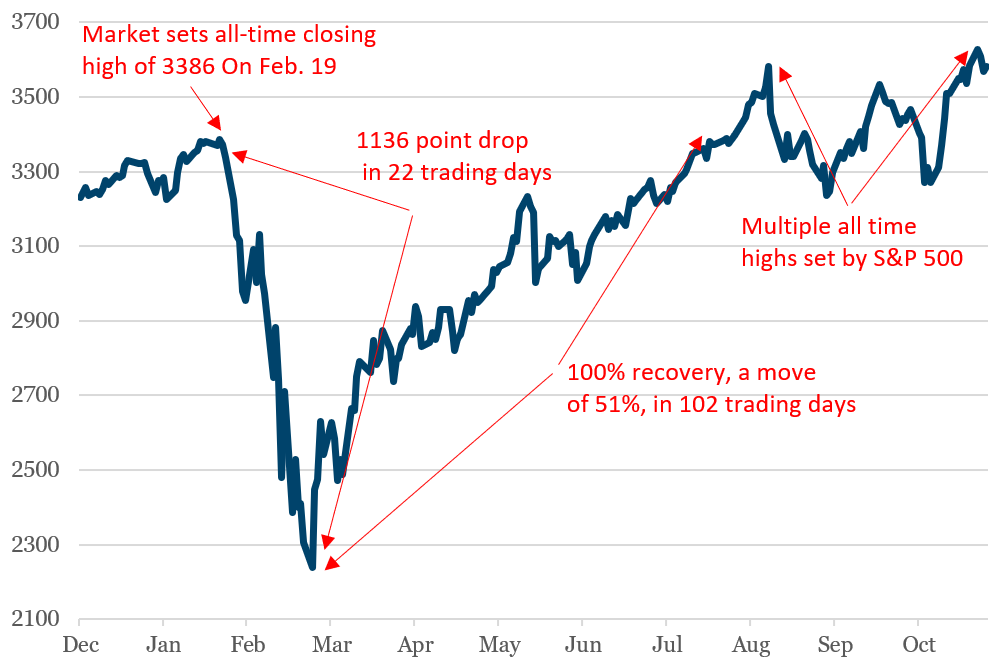|
In more than eight decades of my life, I have experienced many down turns as well as positives enough to fill many essays and dreams. If there is anything I have learned over time, nothing lasts forever. In a flick of an eye, situations – good as well as bad – will change, and normalcy will reclaim our lives, and we will survive and be better for it. Trying to compare our recent year of the covid 19 virus with past experiences can be difficult. The year 2020 has few comparisons unless you go back to 1917 and the Spanish Virus. Obviously, there are very few people who remember those dreadful days. In the over one hundred years since then, there have been many times when we have faced difficult disease outbreaks, and even wars, yet we have survived and found means to overcome adversity. The American Spirit prevails in the darkest of days. Our faith and country go hand in hand meeting the challenges and brushing aside negatives that try to lead astray. The only comparison that I feel is realistic in my family goes back to the early and darkest days of early World War II. Families were split apart with fathers, brothers and other relatives being shipped far away; the print mediums and radio broadcasts highlighted negative news from various fronts, rationing of essentials such as gasoline and rubber prevented people traveling to visit family and friends. Mom found her pantry shelves void of the sugar and spices - many of the essentials necessary to bake the many holiday surprises we were fond of enjoying. I remember how my sister and I felt as young children. Would there ever be another other Christmas like the ones we remembered from our limited past? We were separated from family and friends, even though our parents were tying hard to convince us that Santa Claus would still find us even hundreds of miles from our normal home. It compared to this year in many ways, and yet, we felt blessed that we were still free and able to communicate our lives and loves to those who meant so much to us. Today, we are more fortunate to have many means of communicating instantly to those who are separated from us. With modern conveniences such as computers and cell phones, even though we may be apart, we come together instantly from any part of the country or world. In many cases photos are transmitted just as quickly as voice messages. We are being held together even though we are apart. Yes, today is challenging, yet we know and believe we will overcome all that we are facing. It is in our minds and hearts to be strong and stay the course to a brighter more fulfilling future. Another day…we’re moving on… To address the challenges…others have come and gone. We’ve adjusted to wearing a mask, Though it is made more difficult to complete a task. A burger and fries from a local drive thru, Have replaced group gatherings we once knew. Family and friends stay a distance apart, When a nice hug and kiss would heal a heart. Not having togetherness can be lonely, But let’s not be caught saying…”if only.” Let’s reach out to those we know…many or few, With a call or note or even an e-mail will do. Move on in positive ways, To make these the best of our days. A very Merry Christmas and a much Happier New Year 2021
Happy Holidays. If you are like many Americans, you’re wondering when to take retirement income… and how much. Well, for those of you old enough to remember layaway, this might just work for you. The “layaway” concept is also referred to as “laddering” by many. In other words, let some of the money continue to grow for a while, tap another part of the nest egg for a period of time and then release the balance in a retirement income flow. Let me give you a couple of examples. Now, remember, each situation is different and you will want to confer with your financial professional. Here we go… Let’s say we have a male ready to retire at age 66. He can take Social Security now, as he needs the money, but wants to maximize the value of his Social Security retirement income. Let’s also say that his Social Security retirement income is $2500 per month at age 66. He could leave that Social Security alone until he reaches age 70. That $2500 is guaranteed to grow at 8% per year with no current taxation. Very tough to beat today. But, remember, he needs $2500 per month now. What to do? He could get a 4 or 5 year single premium immediate annuity for the period until he is 70 years old. Then, when that money is finished, he then takes Social Security which is much more than the $2500 at age 66. But, he has other moneys and will need more at age 75. So, he could purchase a fixed index annuity with a lifetime income rider to get the additional income he desires and take retirement income off of this account at age 75. Sound confusing? Let me help. With this concept, your financial professional will only need to ask you two questions. “How much do you need?” And, “when do you need it?” He can give you the exact amount of money you need to put in “layaway” to achieve your retirement income needs. So, let’s empty that worry bucket. Holidays are approaching, and this is one worry we can eliminate.
With bank savings accounts earning pennies in interest, and even long-term certificate of deposit rates averaging less than one percent, it can cause a squeeze in the household finances. One result is some people go on yield safaris, looking for bigger interest game. While there is nothing wrong with trying for higher returns, the concern is that the potential for loss is sometimes overlooked. A decade and a half ago auction rate securities and mortgage bond tranches were sold as low risk, liquid alternatives during a period when bank rates were falling. However, auction rate securities largely became illiquid and many of the “AAA” bonds were reclassified as junk or in default in 2008. This time around some savers were buying packages of small business debt – but the impact of SARS-CoV-2 is causing small businesses to fail. Others are buying dividend paying stocks – often a sound move, but even companies like Ford creased their dividend in 2020. The more adventurous try covered call option writing, where you collect a fee for agreeing to sell a stock you own at a given price. It works well when the stock price is steady; however, all the option fees put together cannot overcome a big drop – like Exxon Mobil share price falling roughly in half in 2020. If you’re a saver looking for a place that pays higher interest than the bank, but still protects your principal and the interest you’ve earned from market loss, the alternative is pretty much coming down to fixed annuities. Although a fixed annuity is not FDIC insured, fixed annuity carriers have an excellent record of protection in both good and bad financial times. There are two main types. A fixed rate annuity pays a locked-in interest rate for a specified number of years – anywhere from one up to ten. A fixed index annuity pays interest based on the performance of an independent index, usually linked to the stock market. Which is better? It depends. With a fixed rate annuity you know what you’re getting. With a fixed index annuity if the index goes down you won’t earn any interest for that year (but you won’t lose what you have). However, the fixed index annuity often offers the potential for considerably more interest, so if the good years offset the bad they could pay much more interest. It ultimately comes down to whether you’re okay with seeing a zero in a given year. Fixed annuities have penalties for early withdrawal called surrender penalties. For fixed rate annuities with multiple year interest guarantees the penalty period usually matches the guarantee period. Fixed index annuity penalty periods are usually for five to ten years. The early penalties are much higher than those imposed on certificates of deposit – so you shouldn’t buy the annuity if you think you’ll need to cash it in early – but you need to look at the entire picture. If your choice is between a CD paying 0.75% and a fixed rate annuity paying 2.5% that has a 6% penalty, you are money ahead with the annuity after four years, even after cashing it in. This is a very tough time for savers, and it doesn’t look like yields will be going up anytime soon. Even so, this isn’t the time to quit the bank and start hunting exotic yield beasts that could come back to bite you. It is a good time to consider moving some of that money to the protected sanctuary of fixed annuities. For educational purposes only. Does not provide investment, tax or legal advice. Information believed accurate, but is not warranted. Not a solicitation to buy or sell any security. Past performance is not an indication of future results. Both investments and fixed annuities involve certain risks; a consumer should consult with their advisor. Fixed annuities are not bank instruments and are not insured by FDIC. It goes without saying that most of us will be glad for 2020 to end, as it has been one of the most exhausting years in modern history. This past year is undeniably one for the history books on many fronts, including: human pandemics, the stock market, the economy, social impacts and politics. There is no doubt students and historians will be studying and analyzing 2020 for decades to come. Amazingly, despite the trials and tribulations 2020 has delivered, as of this writing, the markets are in positive territory for the year, despite being one of the most volatile markets in history. Below we review the events that caused this volatility. 2020 events that are statistically unlikely to reoccur in our lifetime…
S&P 500 (year to date) Planning: Year-End Financial Planning Deadlines As 2020 comes to an end, there may be a few items that need to be completed before the clock strikes midnight on December 31st.
Dream boldly. Plan wisely.
It's time to implement strategies to help reduce your 2020 federal income tax bill and position yourself for future tax savings. Here are some ideas to consider before year end. Gaming the Standard Deduction The Tax Cuts and Jobs Act (TCJA) almost doubled the standard deduction amounts. For 2020, the standard deduction allowances are:
The easiest itemizable expense to prepay is included in home mortgage payments due on January 1, 2021. Accelerating that payment into 2020 will give you 13 months' worth of itemized home mortgage interest deductions for this year. Beware: The TCJA limits these deductions, so consult with your tax advisor before prepaying your mortgage. Other items to consider prepaying are state and local income and property taxes that are due early next year. Prepaying those bills before year end can decrease your 2020 federal income tax bill, because your total itemized deductions will be that much higher. However, the TCJA decreased the maximum amount you can deduct for state and local taxes to $10,000 ($5,000 for married couples who file separate returns). Important: Prepaying state and local taxes can be a bad idea if you'll owe the alternative minimum tax (AMT) this year. That's because write-offs for state and local taxes are completely disallowed under the AMT rules. Therefore, prepaying those expenses may do little or no good for people who are subject to the AMT. Fortunately, the TCJA eased the AMT rules, so most people are no longer at risk. To maximize your itemized deductions for 2020, you also could make bigger charitable donations this year and then make smaller donations next year to compensate. Or you might consider accelerating elective medical procedures, dental work and expenditures for vision care. If you itemize for 2020, you can deduct medical expenses to the extent they exceed 7.5% of your adjusted gross income (AGI). Next year, the deduction threshold is scheduled to rise to 10% of AGI. Managing Gains and Losses in Taxable Investment Accounts If you hold investments in taxable brokerage firm accounts, consider the tax advantage of selling appreciated securities that have been held for over 12 months. The federal income tax rate on long-term capital gains can be as high as 20%, plus the 3.8% net investment income tax (NIIT) can also apply at higher income levels. (See "Current Individual Federal Income Tax Rate Scene" at right.) To the extent you have capital losses from earlier this year or capital loss carryovers from prior years, selling appreciated investments this year won't result in a tax hit. In particular, sheltering net short-term capital gains with capital losses is a tax-smart move because net short-terms gains would otherwise be taxed at higher ordinary income rate of up to 37%. Conversely, if you have some loser investments — that are currently worth less than what you paid for them — you might want to unload them. Taking the resulting capital losses this year would allow you to shelter capital gains, including high-taxed short-term gains, from other sales this year. If selling some loser investments would cause your 2020 capital losses to exceed your 2020 capital gains, the result would be a net capital loss for the year. It can be used to shelter up to $3,000 of 2020 income from salaries, bonuses, self-employment income, interest income and royalties ($1,500 for married couples who file separate returns). Any excess net capital loss can be carried forward indefinitely. A capital loss carryover can be used to shelter short- and long-term gains recognized next year and beyond. This can give you extra investing flexibility in those years, because you won't have to hold appreciated securities for over a year to get a lower tax rate. You'll pay 0% to the extent you can shelter gains with your loss carryover. Depending on future tax rate changes, these loss carryovers can be quite valuable. Donating to Charities You can also make gifts to your favorite charities in conjunction with an overall revamping of your investments in taxable brokerage firm accounts. But there are two principles to keep in mind. First, don't give away investments that are currently worth less than what you paid for them. Instead, sell the shares and book the resulting tax-saving capital loss. Then you can give the cash sales proceeds to favored charities — plus, if you itemize, you can claim the resulting tax-saving charitable write-offs. The second principle applies to investments in appreciated securities. These winning investments should be donated directly to a preferred charity. Why? Because, if you itemize, donations of publicly traded shares that you've owned for over a year result in charitable deductions equal to the full current market value of the shares at the time of the gift. Plus, when you donate appreciated shares, you escape any capital gains taxes on those shares. Meanwhile, the tax-exempt charitable organization can sell the donated shares without owing federal taxes. Gifting to Family Members The principles for tax-smart gifts to charities also apply to gifts to relatives. That is, you should sell loser investments and collect the resulting tax-saving capital losses. Then give the cash sales proceeds to loved ones. Likewise, you should give appreciated shares directly to relatives. In many cases, they'll pay a lower tax rate than you would if you sold the same shares. Making Charitable Donations From Your IRA IRA owners and beneficiaries who have reached age 70½ are permitted to make cash donations totaling up to $100,000 to IRS-approved public charities directly out of their IRAs. You don't owe income tax on these qualified charitable distributions (QCDs), but you also don't receive an itemized charitable contribution deduction. The upside is that the tax-free treatment of QCDs equates to an immediate 100% federal income tax deduction without having to worry about restrictions that can delay itemized charitable write-offs. Contact your tax advisor if you want to hear about the benefits of QCDs. If you're interested in taking advantage of this strategy for 2020, you'll need to arrange with your IRA trustee for money to be paid out to one or more qualifying charities before year end. Prepaying College Tuition Bills The TCJA retains two valuable tax credits for higher education costs. 1. American Opportunity credit. This credit equals 100% of the first $2,000 of qualified postsecondary education expenses, plus 25% of the next $2,000 (assuming the phaseout rule explained later doesn't affect you). So, the maximum annual credit is $2,500. For 2020, the American Opportunity credit is phased out (reduced or eliminated) if your modified adjusted gross income (MAGI) is between:
For 2020, the Lifetime Learning credit is phased out if your MAGI is between:
Specifically, you can claim a 2020 credit based on prepaying tuition for academic periods that begin in January through March of next year. If your MAGI is too high to be eligible for the Lifetime Learning credit, you might still qualify to deduct up to $2,000 or $4,000 of college tuition costs for 2020. If so, consider prepaying tuition bills that aren't due until early 2021 if that would result in a bigger deduction this year. As with the credits, your 2020 tuition and fees deduction can be based on prepaying tuition for academic periods that begin in the first three months of 2021. Important: The higher education tuition and fees deduction is scheduled to expire after 2020, unless Congress passes legislation to extend it. Deferring Income Into Next Year — or Not If you expect to be in the same or lower tax bracket next year, you might want to defer some taxable income from 2020 into 2021. For example, if you operate a small business that uses the cash method of accounting, you can postpone taxable income by waiting until late in the year to send out some invoices. That way, you won't receive payment for them until early 2021. Small business owners can also defer taxable income by accelerating some deductible business expenditures into this year. Both moves will postpone taxable income from this year until next year when it might be taxed at lower rates. Deferring income can also be helpful if you're affected by unfavorable phase-out rules that reduce or eliminate various tax breaks, such as the child tax credit and the higher-education tax credits. On the other hand, if you expect to be in a higher tax bracket in 2021, consider accelerating income into this year (if possible) and postponing deductible expenditures until 2021. Converting an IRA to a Roth IRA The best scenario for converting a traditional IRA into a Roth account is when you expect to be in the same or higher tax bracket during retirement. Currently, tax rates are low by historical standards, but there's been discussion of increasing taxes in the future to fund COVID-19 financial relief measures and various spending priorities. So, now might be a good time to consider a conversion. Beware: There's a current tax cost for converting. A conversion is treated as a taxable liquidation of your traditional IRA followed by a nondeductible contribution to the new Roth account. If you wait to convert your account until 2021 or later, the tax cost could be higher, depending on future tax rates. After the conversion, all the income and gains that accumulate in the Roth account, and all qualified withdrawals, will be federal-income-tax-free. In general, qualified withdrawals are those taken after:
Meet With a Tax Pro The future of federal income taxes for individuals is uncertain. But at least you know the rules that will apply for 2020. Contact your tax advisor to discuss ways to best position yourself for this year and beyond.
|











